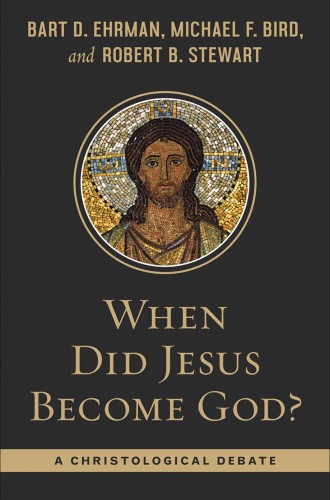Debating the nature of Jesus
A thoughtful book that includes a lively conversation between New Testament scholars Bart Ehrman and Michael Bird

When Did Jesus Become God?
A Christological Debate
In 2022, Ligonier Ministries conducted a survey called “The State of Theology” to explore how Americans respond to various theological questions. Among clergy whom I follow on social media, the results garnered dismay, frustration, confusion, and—if memory serves—a couple of facepalm and eye roll emoji combos. One statement to which respondents were asked to reply said, “Jesus was a great teacher, but he was not God.” Of the evangelical Christian respondents, 44 percent either somewhat or strongly agreed with the statement! Mainline Protestant numbers were not far from the US public generally: 49 percent agreed that Jesus was not God.
The US church has a Christology crisis on its hands. It will need more than a book to remedy it. Still, When Did Jesus Become God? affords clergy and laity alike a wonderful little resource for thinking more deeply and carefully about Jesus, the New Testament, and Christian tradition.
Read our latest issue or browse back issues.
Robert Stewart opens the book with a wonderfully helpful primer on how to assess the arguments historians make. He begins with a list of “preliminary instructions” (such as “Judge a hypothesis from start to finish” and “An argument or a hypothesis is not evidence”) that are elementary yet essential for reading well. These instructions give way to several quick but useful summaries about essential parts of logical argumentation. He introduces readers to types of epistemic defeaters, forms of reasoning (including a very helpful section on abductive reasoning), and ways one might string together an argument.
More specific to the content of the book, Stewart also introduces notable features of arguments about the historical Jesus. He briefly discusses the “criteria of authenticity,” which were once quite the rage among New Testament scholars who sought to identify the authentic sayings of the historical Jesus. Stewart’s overview of these criteria echoes the hesitancy many New Testament scholars feel about them today.
Stewart’s chapter prepares readers for the book’s main feature: a transcript of a debate between two well-known New Testament scholars, Bart Ehrman and Michael Bird, which was held at New Orleans Baptist Theological Seminary in 2016. The book includes opening statements and responses from both scholars as well as a question-and-answer session.
As the title suggests, the debate centers on a christological question: When did Jesus become God? For Ehrman, as a theological question this is a nonstarter, since he does not think Jesus ever became God. (An eager audience member asks a very detailed question about whether Ehrman believes in Jesus’ hypostatic union, salvific death, resurrection, and so on, to which Ehrman responds, “No, I don’t believe any of that,” and briefly shares his story of moving into and out of Christian faith.) Instead, Ehrman attempts to answer the question, “When did the followers of Jesus start believing that he was God?”
For Ehrman, the first Christians to believe Jesus was God did so when they began to believe God had raised Jesus from the dead. Ehrman points out that the earliest gospel, Mark, depicts the disciples as struggling even to see Jesus as the Messiah, let alone understanding his divinity. Ehrman takes this as a strong indicator that the disciples did not believe Jesus was God during Jesus’ lifetime (though he recognizes that the author of Mark may have believed Jesus was divine at his baptism). Ehrman points to passages in Acts and Romans that, he contends, show that the earliest Christians saw Jesus’ resurrection as the moment when God adopted Jesus into the divine life (or made him divine somehow, anyway).
But Ehrman recognizes that the New Testament appears to bear witness to a variety of opinions about when Jesus became God. If the very earliest followers of Jesus believed he became God at the resurrection, then later generations began to believe he became God at his baptism (Mark) or his birth (Matthew and Luke) or was God from the beginning (John). Ehrman notes that between Christ’s resurrection and the Council of Nicaea in 325, the church entertained a variety of answers to the question of when (and how) Jesus became God. Those other options (including adoptionism) lost out at Nicaea, if not before then, for various reasons that Ehrman does not elaborate on in this debate.
Bird’s opening statement casts doubt on Ehrman’s argument in numerous ways. He challenges Ehrman’s exegesis of relevant New Testament texts, his handling of Jewish and Greco-Roman sources, and his claims that certain groups held to adoptionist theology. Bird’s argument relies heavily on what Stewart calls “undercutting defeaters,” which cast doubt on a conclusion without making it entirely untenable. By casting doubt on Ehrman’s interpretation of various sources, Bird attempts to show that neither New Testament texts nor the earliest Christian authors subscribed to the idea of adoptionism. In his conclusion, Bird suggests that adoptionism—which he argues is inherently dependent on merit—is incongruous with the “gospel of grace as the early church knew it.” The alternative Bird commends, by way of quoting Justo González, is Nicene: Jesus “must be more than the adopted son of God. He must be God adopting us as sons and daughters.”
The responses further clarify the position each scholar puts forward, and the question-and-answer section sheds a bit more light on various points within the debate. Overall, in my estimation, there is no clear winner in this debate. Instead, the debate helps those listening to it realize that negotiating New Testament texts and church history can be quite difficult. What I appreciate about both Ehrman and Bird is that they aren’t interested in making things more complicated (as some scholars like to do). Rather, they aim to make the New Testament more accessible to people without academic training.
Yet making ancient texts genuinely accessible requires dealing seriously with the complexities that enshroud the New Testament and early Christian texts. Some of these are historical and literary complexities. What sorts of writing are the gospels anyway? How much do Paul’s writings reflect his Jewish or his Roman context and traditions? Other complexities are more theological. How does the Spirit reveal the truth about Jesus? Must it have happened all at once, like a flash of lightning, or could it have dawned more slowly over the course of generations, even centuries? And how do we reckon with and relate to the theological diversity of the church’s first centuries? While these complexities are real and serious, they need not prevent us from seeking the most plausible conclusions about who Christ was and is.
This book provides some of the basic tools to start engaging these complexities more thoughtfully. It also provides two accessible responses to an important question about Christology, which might serve as case studies for practicing analysis of historical arguments—whether those arguments focus on who Christ was or wasn’t, what the Bible says, or what the church has taught. I imagine this book serving very well for a small group whose members want to pursue important questions, engage in charitable and convicted debate, and love God and neighbor well with their minds.
This book won’t give you a clear answer to the christological question. But it will give you tools and resources to think more deeply (and, I hope, more passionately) about who Jesus was, is, and will be. I like how Ehrman puts it: “Saying [Jesus] is God is the beginning of the question, not the end of it.”





